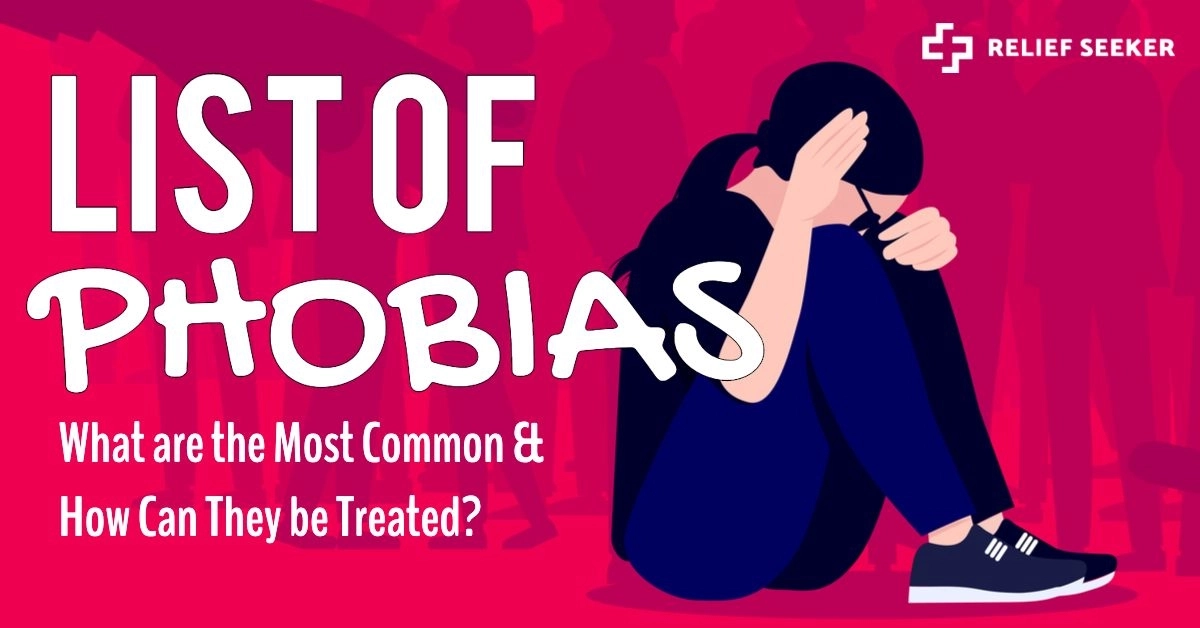What Is A Phobia?
According to some brilliant researchers at Harvard Medical School, “A phobia is a persistent, excessive, unrealistic fear of an object, person, animal, activity or situation.”
Phobias are a type of anxiety disorder; it is said thatmore than 30% of adults in the U.S. suffer from an anxiety disorder such as Social Anxiety at some point in their lives. A person with a phobia either try to avoid the thing that triggers the fear or endures it with greatanxiety and distress. And either way, you slice it, it’s not an easy feat.
The Diagnostic and Statistical Manual of Mental Disorders, Fifth Edition (DSM-5) states that specific phobias, such as hydrophobia (the fear of water), fall into five categories. These categories are:
Fears related to animals
dogs, snakes, or bugs
Fears associated with the natural environment
heights, thunder, or darkness
Fears related to blood, injury, or medical issues
injections, broken bones, or being at a hospital
Fears related to specific situations
Driving, falling, flying
Other - these are usually the more obscure phobias that can’t be categorized easily
Halloween, loud noises, the color purple
The above phobia categories encompass an infinite amount of specific objects and situations. Phobias are not a one size fits all kind of thing mostly, because you can basically be scared of anything, and there are an infinite amount of places, situations, and objects; the list is like that song we sang as kids, ‘This is the song that doesn’t end…,” it goes on forever. It is estimated that specific phobias affect a little more than 12% of American adultsand, if not appropriately treated by a mental health professional, can be life-altering and affect a person’s everyday life.
Since there is no official list of phobias outside of what the DSM-5 has put together, there are certain times when researchers and clinicians come up with names when a new fear surfaces. And, did you know, there’s a fear of fears?! Say What?! It was coined phobophobia and is more common than you may think.
As discussed earlier in the article, phobias are categorized as anxiety disorders, and people who suffer from these types of conditions can sometimes experience anxiety or panic attacks. These types of attacks can be terrifying, and generally, people will do everything in their power to avoid having another one. Think about it; say you’re out surfing with a bunch of friends, and you start to have a panic attack. This could lead to one of two things. You could either develop a fear of panic attacks or begin to fear water (hydrophobia). Either way, you’ll probably do what you can to avoid the water or surfing in the future.
Related Article: Panic Attacks vs. Anxiety Attacks
Common Phobias
Since you can virtually be afraid of anything, the list of phobias is super long, so we will spare you and go over the top ten most common phobias and include a bit of detail for better understanding.
Top 10 List of Common Phobias:
Agoraphobia
Acrophobia
Aerophobia
Claustrophobia
Entomophobia
Ophidiophobia
Cynophobia
Astraphobia
Trypanophobia
Social Phobias
The most common amongst many phobias (1 in 20 people suffer from social phobias) and categorized and treated as a major anxiety disorder. This phobia is the fear of social situations and includes people being overly self-conscious when surrounded by other people. Some are so afraid to be around people or social situations that they avoid altogether, or they fear being judged during specific situations, like eating in front of others. The most common form of social phobia is a fear of public speaking.
Agoraphobia - Fear of Open Spaces
This severe fear can literally confine people to their homes, leading to living a normal life pretty impossible. Having a fear of open spaces is more complicated than you might think; it’s not just about the openness but also about specific places or venues. For example, if you don’t like being in an open field because you’re fearful that something terrible could happen, you might also fear that one music venue because you experienced trauma while you were there.
Acrophobia - Fear of Heights
This fear is said to impact over 6% of the world’s adult population and is usually the result of a past traumatic experience. People who suffer from a fear of heights go to great lengths to avoid high places, like towers, tall buildings, or bridges. In extreme cases, some people even avoid riding in elevators or on escalators.
Aerophobia - Fear of Flying
Affecting between 10% and 40% of U.S. adults (the number varies so much due to most cases going undiagnosed), the fear of flying impacts one out of three people on some level, either very little or extreme. Common symptoms experienced by someone with this phobia include trembling, increased heart rate, and feeling disoriented. People with this fear usually try to avoid flying altogether, but with proper treatment, usually, exposure therapy is said to be able to get back into the skies with little to no fear.
Claustrophobia - Fear of Enclosed Spaces
People that suffer from this fear say they feel like the walls are closing in on them and do what they can to avoid places like elevators, small rooms, and even airplanes.
Entomophobia - Fear of Insects
Let’s be honest for a minute, there aren’t very many people that like bugs; they’re small, sometimes scary looking, they crawl, and they bite - EW! People that fear spiders, bugs, or insects hate them so much, and they are fearful that if they’re exposed to one, they might die.
Ophidiophobia - Fear of Snakes
This phobia is pretty standard, and if you’re an Indiana Jones fan, you’ll know that he hated snakes too. The fear of snakes is said to invoke feelings of disgust and usually arise out of fear of disease or contamination. People that fear snakes are usually more so afraid to be bitten since snakes are sometimes poisonous.
Cynophobia - Fear of Dogs
Being scared of dogs is a relatively common phobia that usually affects children, service workers, such as garbage collectors, and mail people. This fear mostly stems from a person having had a negative experience with a dog and is said to be one of the hardest phobias to overcome as many dogs can sense fear and react to it in a given situation.
Astraphobia - Fear of Storms
The fear of storms, such as heavy rain, thunder, or lightning, makes those suffering from this phobia experience overwhelming feelings of anxiety when they encounter certain types of weather. People with this phobia often go to great lengths to avoid storms by hiding under covers, beds, or even ducking into a closed-off space such as a bathroom or closet. This fear can become so extreme that people become preoccupied with checking and tracking the weather patterns daily.
Trypanophobia - Fear of Needles or Injections
Getting a shot of any kind is never fun, and having a needle stuck in your arm can hurt, which makes this fear incredibly common. This phobia affects somewhere between 20% and 30% of American adults and often goes untreated. This fear’s symptoms can be so extreme that people sometimes avoid going to the doctor or dentist even when they have an ailment that desperately needs attention.
Less Common and Unique Phobias
Now that we’ve covered the more common phobias, we can now talk about the less common and unique fears people may suffer from. These phobias are usually particular, go undiagnosed or untreated, and only affect a small percentage of the population. People with unusual phobias tend to be ashamed or embarrassed about what scares them, so they don’t report it to their doctor. This makes less common phobias incredibly hard to diagnose, and because of this, little research can be done.
A few examples of less common and unique phobias are:
Bibliophobia - fear of books
Chromophobia - fear of colors
Domatophobia - fear of houses
Ephebiphobia - fear of teenagers
Genuphobia - fear of knees
Hippopotomonstrosesquipedaliophobia - fear of long words
Koumpounophobia - fear of buttons
Pogonophobia - fear of beards
Nephophobia - fear of clouds
Octophobia - fear of figure 8
Samhainophobia - fear of Halloween
Wiccaphobia - fear of witches or witchcraft
Treatment for Phobias
In general, phobias are treated with a thoughtful combination of therapy and medication. There are many options for finding a mental health provider. Online therapy has become an increasingly popular option for people looking to talk to a mental health professional. It offers people an easy and convenient way to communicate their feelings over the internet, using a smartphone or computer. There is no need to get in the car or account for travel time, and you can schedule a session outside of regular office hours. One provider that we like a ReliefSeeker is Talkspace. Talkspace is an online therapy platform that makes finding a licensed therapist that will work for you super comfortable. Talkspace also offers its clients the option to sign up for their Psychiatry platform, which puts people in touch with licensed Psychiatrists that can prescribe medication if need be.
You can check out our list of comprehensive online therapy options here. The best news is that they have all been pre-vetted and reviewed by one of our team members.
The most effective treatment for specific phobias is called exposure therapy. During exposure therapy, you will work with a psychologist to learn ways to desensitize yourself to the object or situation that causes you to fear by exposing yourself to what makes you scared a little at first, then gradually increase the exposure over time. This treatment can help you change how you feel about the specific object or situation to hopefully control your reactions and adverse feelings.
An example of what you might experience during exposure therapy is if you fear birds, the psychiatrist or therapist may simply have you start by thinking about or talking about birds, then move on to watching videos or looking at pictures with birds in them. And hopefully, after some time, you might be able to go to a place where birds are present, such as a forest or the beach, and not have the uncontrollable fear you once did.
Exposure therapy is usually coupled with relaxation or breathing exercises to help the patient remain calm during each session. Your doctor may also recommend anxiety-reducing medications, such as beta-blockers or benzodiazepines, to help you through the treatment. These medications aren’t necessarily meant to treat phobias but can lower a person’s stress during exposure therapy.
If therapy or online therapy isn’t your thing, there are also support groups, including online support groups available. Support groups are best for people that prefer to be surrounded by people like them; people also who have a specific phobia. Support groups are lead by licensed mental health professionals either at a designated location or online. During these types of meetings, each participant will share what they’re experiencing, allowing each member to feel like they’re not alone -- like they’re not the only person in the world that is also afraid of heights.
One online support group that we prefer is Wisdo. The team at Wisdo has created an app for people to connect with other people suffering from the same or similar conditions. This app is a safe space for its users to talk about their feelings in the comfort of their own home.
Conclusion
It is important to always talk to your doctor or other mental health professional about your feelings or any symptoms you might be experiencing, as they will probably require some form of treatment and medication. Phobias are persistent and unrealistic fears of particular objects or situations. Common phobias are usually fears related to animals, natural environments, medical issues, or other specific situations. Unique phobias are typically lumped into one of those categories but are much less common and can sometimes be unusual, making them much harder to diagnose and treat.
Phobias can be hard to talk about with others, especially if they’re perceived as weird or taboo. But, reaching out to someone you trust, like a best friend or doctor, can help. Overcoming your fears is possible with the right treatment plan. Talking to a therapist or psychiatrist coupled with medication and breathing or relaxation exercises might just be the answer you’re looking for.
If you think you or someone you love might have a phobia that causes significant disruption in your life, speak to your doctor about scheduling an evaluation and possible treatment options.


